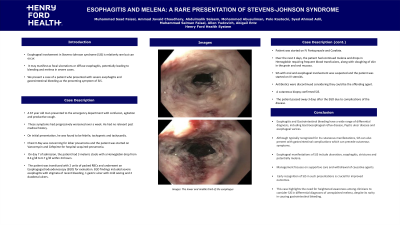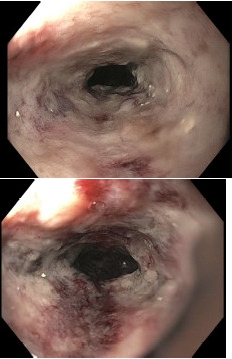Monday Poster Session
Category: GI Bleeding
P2527 - Esophagitis and Melena: A Rare Presentation of Stevens-Johnson Syndrome
Monday, October 28, 2024
10:30 AM - 4:00 PM ET
Location: Exhibit Hall E

Has Audio

Muhammad Saad Faisal, MD
Henry Ford Health
Detroit, MI
Presenting Author(s)
Muhammad Saad Faisal, MD1, Ammad Javaid. Chaudhary, MD1, Abdulmalik Saleem, MD1, Mohammed Abusuliman, MD1, Polo Kostecki, DO2, Syed Ahmad Adil, MD1, Muhammad Salman Faisal, MD1, Allen Yudovich, MD1, Abigail Entz, MD1
1Henry Ford Health, Detroit, MI; 2Henry Ford Hospital, Detroit, MI
Introduction: Esophageal involvement in Stevens-Johnson syndrome (SJS) is relatively rare but can occur. It may manifest as focal ulcerations or diffuse esophagitis, potentially leading to bleeding and melena in severe cases. We present a case of a patient who presented with severe esophagitis and gastrointestinal bleeding as the presenting symptom of SJS.
Case Description/Methods: A 67-Year-old- man presented to the emergency department with confusion, agitation and productive cough. These symptoms had progressively worsened over a week. He had no relevant past medical history.
On initial presentation, he was found to be febrile, tachypneic and tachycardic. Chest X-Ray was concerning for lobar pneumonia and the patient was started on Vancomycin and Cefepime for hospital-acquired-pneumonia. On day 7 of admission, the patient had 3 melenic stools with a Hemoglobin drop from 8.4 g/dl to 6.7 g/dl within 24 hours. The patient was transfused with 2 units of packed RBCs and underwent an Esophagogastroduodenoscopy (EGD) for evaluation. EGD findings included severe esophagitis with stigmata of recent bleeding, 1 gastric ulcer with mild oozing and 2 duodenal ulcers. Patient was started on IV Pantoprazole and Carafate.
Over the next 2 days, the patient had continued melena and drops in Hemoglobin requiring frequent blood transfusions, along with sloughing of skin in the groin and oral mucosa. SJS with oral and esophageal involvement was suspected and the patient was started on IV steroids. Antibiotics were discontinued considering they could be the offending agent. A cutaneous biopsy confirmed SJS. The patient passed away 3 days after the EGD due to complications of the disease
Discussion: Esophagitis and Gastrointestinal bleeding have a wide range of differential diagnosis, including Gastroesophageal reflux disease, Peptic ulcer disease and esophageal varices. Although typically recognized for its cutaneous manifestations, SJS can also present with gastrointestinal complications which can precede cutaneous symptoms.
Esophageal manifestations of SJS include ulceration, esophagitis, strictures and potentially melena. Management focuses on supportive care and withdrawal of causative agents. Early recognition of SJS in such presentations is crucial for improved outcomes. This case highlights the need for heightened awareness among clinicians to consider SJS in differential diagnoses of unexplained melena, despite its rarity in causing gastrointestinal bleeding.

Disclosures:
Muhammad Saad Faisal, MD1, Ammad Javaid. Chaudhary, MD1, Abdulmalik Saleem, MD1, Mohammed Abusuliman, MD1, Polo Kostecki, DO2, Syed Ahmad Adil, MD1, Muhammad Salman Faisal, MD1, Allen Yudovich, MD1, Abigail Entz, MD1. P2527 - Esophagitis and Melena: A Rare Presentation of Stevens-Johnson Syndrome, ACG 2024 Annual Scientific Meeting Abstracts. Philadelphia, PA: American College of Gastroenterology.
1Henry Ford Health, Detroit, MI; 2Henry Ford Hospital, Detroit, MI
Introduction: Esophageal involvement in Stevens-Johnson syndrome (SJS) is relatively rare but can occur. It may manifest as focal ulcerations or diffuse esophagitis, potentially leading to bleeding and melena in severe cases. We present a case of a patient who presented with severe esophagitis and gastrointestinal bleeding as the presenting symptom of SJS.
Case Description/Methods: A 67-Year-old- man presented to the emergency department with confusion, agitation and productive cough. These symptoms had progressively worsened over a week. He had no relevant past medical history.
On initial presentation, he was found to be febrile, tachypneic and tachycardic. Chest X-Ray was concerning for lobar pneumonia and the patient was started on Vancomycin and Cefepime for hospital-acquired-pneumonia. On day 7 of admission, the patient had 3 melenic stools with a Hemoglobin drop from 8.4 g/dl to 6.7 g/dl within 24 hours. The patient was transfused with 2 units of packed RBCs and underwent an Esophagogastroduodenoscopy (EGD) for evaluation. EGD findings included severe esophagitis with stigmata of recent bleeding, 1 gastric ulcer with mild oozing and 2 duodenal ulcers. Patient was started on IV Pantoprazole and Carafate.
Over the next 2 days, the patient had continued melena and drops in Hemoglobin requiring frequent blood transfusions, along with sloughing of skin in the groin and oral mucosa. SJS with oral and esophageal involvement was suspected and the patient was started on IV steroids. Antibiotics were discontinued considering they could be the offending agent. A cutaneous biopsy confirmed SJS. The patient passed away 3 days after the EGD due to complications of the disease
Discussion: Esophagitis and Gastrointestinal bleeding have a wide range of differential diagnosis, including Gastroesophageal reflux disease, Peptic ulcer disease and esophageal varices. Although typically recognized for its cutaneous manifestations, SJS can also present with gastrointestinal complications which can precede cutaneous symptoms.
Esophageal manifestations of SJS include ulceration, esophagitis, strictures and potentially melena. Management focuses on supportive care and withdrawal of causative agents. Early recognition of SJS in such presentations is crucial for improved outcomes. This case highlights the need for heightened awareness among clinicians to consider SJS in differential diagnoses of unexplained melena, despite its rarity in causing gastrointestinal bleeding.

Figure: Lower third and Middle third of the Esophagus
Disclosures:
Muhammad Saad Faisal indicated no relevant financial relationships.
Ammad Chaudhary indicated no relevant financial relationships.
Abdulmalik Saleem indicated no relevant financial relationships.
Mohammed Abusuliman indicated no relevant financial relationships.
Polo Kostecki indicated no relevant financial relationships.
Syed Ahmad Adil indicated no relevant financial relationships.
Muhammad Salman Faisal indicated no relevant financial relationships.
Allen Yudovich indicated no relevant financial relationships.
Abigail Entz indicated no relevant financial relationships.
Muhammad Saad Faisal, MD1, Ammad Javaid. Chaudhary, MD1, Abdulmalik Saleem, MD1, Mohammed Abusuliman, MD1, Polo Kostecki, DO2, Syed Ahmad Adil, MD1, Muhammad Salman Faisal, MD1, Allen Yudovich, MD1, Abigail Entz, MD1. P2527 - Esophagitis and Melena: A Rare Presentation of Stevens-Johnson Syndrome, ACG 2024 Annual Scientific Meeting Abstracts. Philadelphia, PA: American College of Gastroenterology.
